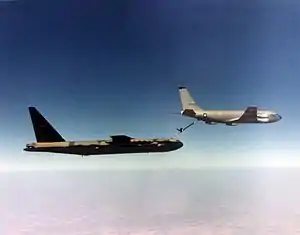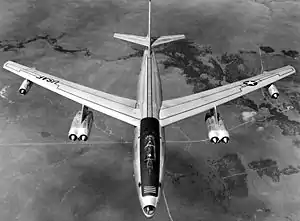322d Expeditionary Reconnaissance Squadron
The 322d Expeditionary Reconnaissance Squadron is a provisional unit of the United States Air Force, assigned to Air Combat Command to activate or inactivate as needed.
| 322d Expeditionary Reconnaissance Squadron | |
|---|---|
 KC-135A refuels B-52D during Vietnam War | |
| Active | 1942–1945; 1950–1957; 1963–1968 |
| Country | |
| Branch | |
| Role | Bombardment |
| Part of | Air Combat Command |
| Engagements | European Theater of Operations |
| Decorations | |
| Insignia | |
| 322d Bombardment Squadron emblem (approved 12 October 1942)[1] |  |
The squadron was first activated in 1942 as the 322d Bombardment Squadron. After training in the United States, the squadron entered combat in the European Theater of Operations, where it was awarded two Distinguished Unit Citations for its actions. Following V-E Day, the squadron returned to the United States, where it was inactivated.
The squadron was redesignated the 322d Strategic Reconnaissance Squadron and activated at Barksdale Air Force Base, Louisiana in 1950. Squadron elements deployed and again saw combat during the Korean War. It was inactivated at Lockbourne Air Force Base, Ohio in 1957. In 1963, it returned to the bombardment role at Glasgow Air Force Base, Montana. It deployed crews and aircraft to Andersen Air Force Base, which participated in the Vietnam War. The squadron was inactivated on 25 June 1968 as Glasgow closed and older models of the Boeing B-52 Stratofortress were withdrawn from service.
History
World War II

The squadron was first activated in April 1942 at Harding Field, Louisiana as the 322d Bombardment Squadron, one of the original squadrons of the 91st Bombardment Group and equipped with Boeing B-17 Flying Fortresses.[1][2] The squadron was organized as part of Third Air Force in the southeastern United States before moving to Walla Walla Army Air Base, Washington for final training under Second Air Force.
The squadron deployed to the European Theater of Operations, where it became part of VIII Bomber Command. It was one of the first heavy bombardment squadrons to arrive in England. The 322d flew combat missions over Nazi Germany and Occupied Europe until the surrender of Germany in May 1945. The squadron returned to the United States where it was programmed to become a Boeing B-29 Superfortress squadron. The surrender of Japan canceled these plans and it was inactivated during November 1945.[1]
Strategic reconnaissance


The squadron was redesignated the 322d Strategic Reconnaissance Squadron and activated at Barksdale Air Force Base, Louisiana in July 1950 as a result of the Korean War. The squadron was initially equipped with RB-29 reconnaissance bombers, but soon converted to the North American RB-45 Tornado jet reconnaissance aircraft. Elements of the squadron flew reconnaissance and mapping combat missions over Korea until mid-1952. The squadron deployed to Johnson Air Base and Yokota Air Base, Japan from activation until 28 May 1952. In September 1951 the squadron moved to Lockbourne Air Force Base, Ohio, where it re-equipped with Boeing RB-47E Stratojets. The squadron performed various worldwide reconnaissance missions until inactivating in November 1957.[1]
Strategic bombardment
Once again designated as a bombardment squadron, the 322d was activated in February 1963 at Glasgow Air Force Base, Montana,[1] where it assumed the mission, personnel and Boeing B-52D Stratofortress bombers of the 326th Bombardment Squadron.[3] Most of the squadron deployed to the Western Pacific, where the flew Operation Arc Light combat missions over Southeast Asia, flying missions from Andersen Air Force Base between 11 September 1966 and 31 March 1967 and from Kadena Air Base between 15 February and 30 April 1968, operating as part of the Bombardment Wing, Provisional, 4133d. Upon returning from its last deployment the squadron became non-operational and was inactivated on 25 June 1968[1] as Glasgow closed.
Lineage
- Constituted as the 322d Bombardment Squadron (Heavy) on 28 January 1942
- Activated on 15 April 1942
- Redesignated 322d Bombardment Squadron, Heavy on 20 August 1943
- Inactivated on 7 November 1945
- Redesignated 322d Strategic Reconnaissance Squadron, Medium on 23 May 1950
- Activated on 6 July 1950
- Inactivated on 8 November 1957
- Redesignated 322d Bombardment Squadron, Heavy and activated on 15 November 1962 (not organized)
- Organized on 1 February 1963
- Inactivated on 25 June 1968
- Redesignated 322d Expeditionary Reconnaissance Squadron on 22 July 2010[1]
Assignments
- 91st Bombardment Group, 15 April 1942 – 7 November 1945
- 91st Strategic Reconnaissance Group, 6 July 1950
- 91st Strategic Reconnaissance Wing, 28 May 1952 – 8 November 1957
- Strategic Air Command, 15 November 1962 (not organized)
- 91st Bombardment Wing, 1 February 1963 – 25 June 1968
- Air Combat Command to activate or inactivate as needed[1]
Stations
- Harding Field, Louisiana, 15 April 1942
- MacDill Field, Florida, 16 May 1942
- Walla Walla Army Air Base, Washington, c. 28 June - 24 August 1942
- RAF Kimbolton (Station 117),[4] England, 13 September 1942 (ground echelon), early October 1942 (air echelon)
- RAF Bassingbourn (Station 121),[4] England, 14 October 1942 – 23 June 1945
- Drew Field, Florida, 3 July - 7 November 1945
- Barksdale Air Force Base, Louisiana, 6 July 1950
- Lockbourne Air Force Base, Ohio, 11 September 1951 – 8 November 1957
- Glasgow Air Force Base, Montana, 1 February 1963 – 25 June 1968[1]
Aircraft
- Boeing B-17 Flying Fortress, 1942–1945
- Boeing RB-29 Superfortress, 1950
- North American RB-45C Tornado, 1950–1953
- Boeing RB-47E Stratojet, 1953–1957
- Boeing B-52D Stratofortress, 1963–1968[1]
References
Notes
- Robertson, Patsy (30 July 2012). "Factsheet 322 Expeditionary Reconnaissance Squadron (ACC)". Air Force Historical Research Agency. Retrieved 11 November 2015.
- Maurer, Combat Units, pp. 156–158
- Maurer, Combat Squadrons, pp. 401–402
- Station number in Anderson
Bibliography
![]() This article incorporates public domain material from the Air Force Historical Research Agency website http://www.afhra.af.mil/.
This article incorporates public domain material from the Air Force Historical Research Agency website http://www.afhra.af.mil/.
- Anderson, Capt. Barry (1985). Army Air Forces Stations: A Guide to the Stations Where U.S. Army Air Forces Personnel Served in the United Kingdom During World War II (PDF). Maxwell AFB, AL: Research Division, USAF Historical Research Center. Archived from the original (PDF) on 4 March 2016. Retrieved 7 July 2012.
- Maurer, Maurer, ed. (1983) [1961]. Air Force Combat Units of World War II (PDF) (reprint ed.). Washington, DC: Office of Air Force History. ISBN 0-912799-02-1. LCCN 61060979.
- Maurer, Maurer, ed. (1982) [1969]. Combat Squadrons of the Air Force, World War II (PDF) (reprint ed.). Washington, DC: Office of Air Force History. ISBN 0-405-12194-6. LCCN 70605402. OCLC 72556.
- Ravenstein, Charles A. (1984). Air Force Combat Wings, Lineage & Honors Histories 1947–1977. Washington, DC: Office of Air Force History. ISBN 0-912799-12-9.